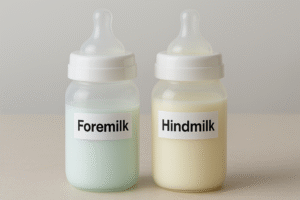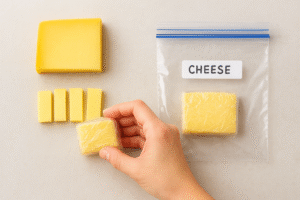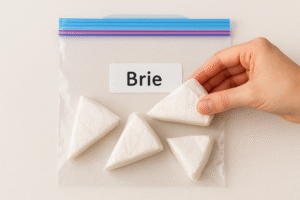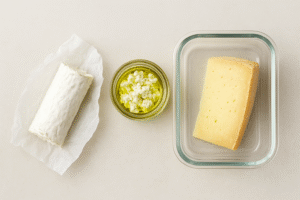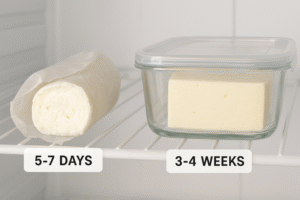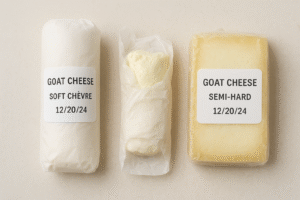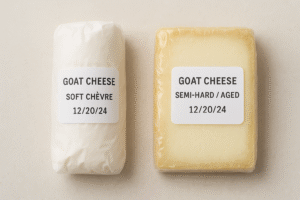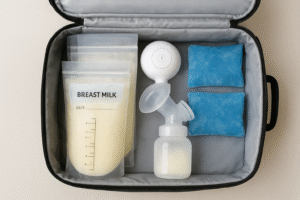Why U.S. Moms Ask About Freezing Goat Cheese
If you’re a U.S. mom who loves creamy, flavorful goat cheese but ends up with leftovers, you might wonder if freezing is safe. The good news? It is — as long as you do it right. Freezing can help you save money, cut waste, and always have cheese ready for family meals.
In this guide, you’ll learn how to freeze, thaw, and store goat cheese safely, following trusted U.S. food safety standards from the USDA and insights from the Good Housekeeping Institute.
If you also store goat milk at home, check out our full guide on how to freeze goat milk safely for longer use.
🧩 Understanding Goat Cheese Types Before Freezing
Not all goat cheese freezes the same way — and knowing the difference helps you keep the right texture.
Soft, spreadable cheeses like chèvre are rich in moisture, which means they can become slightly crumbly after thawing. Semi-hard and aged goat cheeses, on the other hand, freeze beautifully and retain their texture and flavor for months.
For best results:
- Freeze soft chèvre for up to 2–3 months.
- Store semi-hard cheese for 4–6 months.
- Keep aged goat cheese frozen for up to 6 months or longer without major flavor loss.
👉 Always freeze cheese while it’s still fresh. Waiting too long reduces both quality and taste.
❄️ How to Freeze Goat Cheese Like a Pro
Freezing cheese properly helps lock in flavor and texture. Here’s the step-by-step process U.S. moms swear by:
- Divide into portions: Slice or cube cheese into small, one-meal servings.
- Wrap securely: Use cling wrap, then seal inside a freezer-safe bag or airtight container.
- Label clearly: Include the cheese type and date — just like you would when labeling frozen breast milk or leftovers.
- Freeze fast: Place in the coldest part of your freezer (0°F / –18°C) for best preservation.
To learn more about proper labeling and airtight storage, see our detailed guide on Breast Milk Storage for U.S. Moms.
🧊 The Right Way to Thaw Goat Cheese
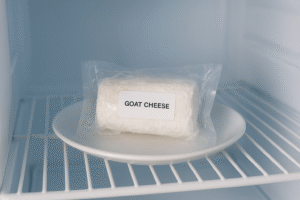
When you’re ready to use your cheese, thaw it gently — not fast. Move it from the freezer to the fridge and let it rest overnight.
If you’re in a hurry, place the sealed package in cool (not hot) water for 30–60 minutes. Avoid microwaving or heating directly, as that can damage both nutrients and texture.
Once thawed, goat cheese should be consumed within 3–4 days, and never refrozen.
🧺 Keeping the Creamy Texture Intact

Want your thawed cheese to taste as good as fresh? Add a spoon of olive oil or milk to soft chèvre to restore smoothness. Use thawed cheese in warm dishes like omelets, casseroles, or pasta — you’ll barely notice the difference.
According to USDA Food Safety recommendations, cheese frozen for up to six months remains safe if stored in airtight conditions, though best taste is within the first few months. The Good Housekeeping Institute also confirms that semi-hard and aged varieties hold up better than soft ones during freezing.
🚫 Common Mistakes to Avoid
❌ Freezing cheese without wrapping — leads to freezer burn.
❌ Keeping it near strong-smelling foods — absorbs unwanted odors.
❌ Thawing at room temperature — increases bacteria growth.
❌ Refreezing thawed cheese — ruins texture permanently.
💬 FAQ: Freezing Goat Cheese
Q1: Can I freeze goat cheese crumbles?
Yes. Keep them sealed in an airtight bag and use within 2–3 months.
Q2: Does freezing change the taste?
A bit. Soft cheeses become more crumbly, but they’re perfect for cooking and baking.
Q3: Can I freeze goat cheese spread?
Yes, but mix it gently after thawing to bring back its creamy consistency.
Q4: Can I freeze dishes made with goat cheese?
Definitely! Cooked meals like pasta, quiche, or lasagna freeze and reheat beautifully.
🧾 Conclusion: Smart Freezing, Zero Waste
Freezing goat cheese is a simple, mom-approved way to reduce waste and save money while keeping your favorite cheese ready for any recipe. Choose firmer types when possible, store them airtight, and thaw slowly in the fridge to enjoy the same creamy, tangy flavor every time.
If you’re curious about goat cheese flavor and pairing ideas, explore our full article on what goat cheese tastes like and how to enjoy it best.
For more expert advice, see Good Housekeeping’s detailed guide on freezing cheese safely and USDA’s cheese storage recommendations.



